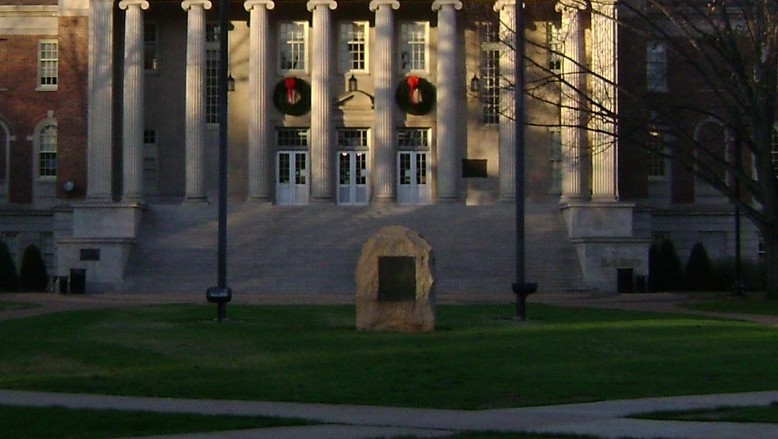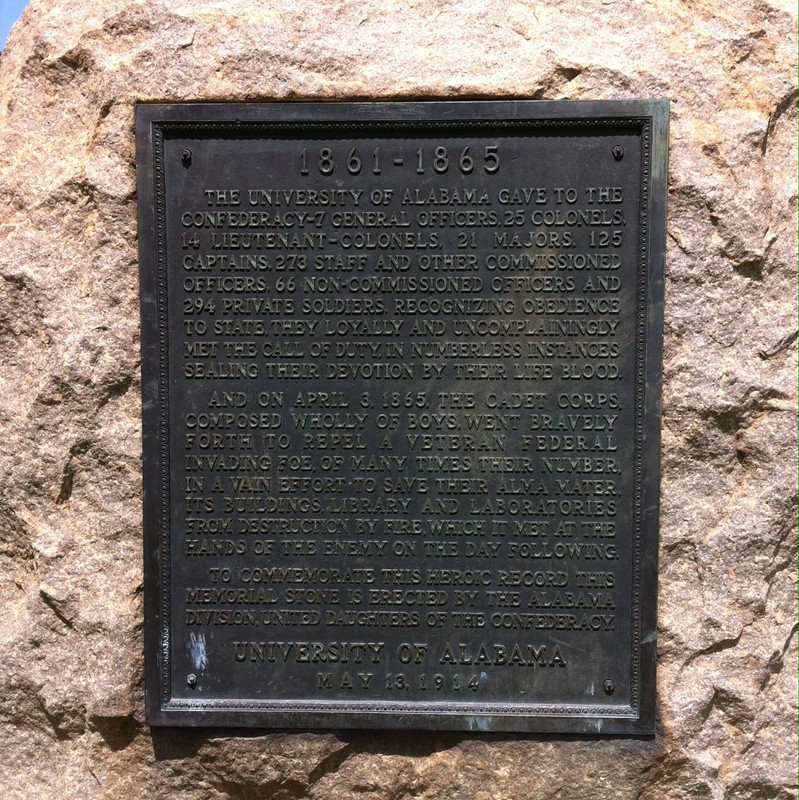UDC Memorial Boulder
Introduction
Text-to-speech Audio
Images
Sitting between the 1895 Alabama state flag and the United States flag, sits the UDC boulder. This is the second of two places it has been, having been moved from the site of the Rotunda ruins, roughly 10 meters behind.

Here is a close of up the bronze plaque which is in the middle of the monument. It comforts those who fought for the confederacy and studied at UA.

A Senior society called 'The Jasons' posed next the UDC boulder. Here you can see the boulder in its original location (the Rotunda), as well as what it looked like just after it was received by UA Corolla 1914 (W. S. Hoole Special Collections)

Backstory and Context
Text-to-speech Audio
“A true history of a nation, defines its civilization and a panorama of events, in word paintings, that never die but survive amid the mutilations of time. ‘Veritas vincit.’”[1]
With the turn of the twentieth century being the most ardent of times for the women of United Daughters of the Confederacy (UDC) to cement a rhetoric of the Lost cause, local chapters across the country committed themselves to the remembrance of lost Confederate ‘sons.’ As president of the Alabama Division of the UDC in 1911, Mrs Chappell Cory inaugurated “the movement to place Confederate markers at the University of Alabama.”[2] Mrs Cory believed a granite boulder and tiffany window would aptly remember the “boy-soldiers who defended the city of Tuscaloosa on the night of Croxton’s raid.”[3] At the 1913 convention, held in Camden AL, Mrs Cory informed the president of Tuscaloosa Chapter, Mrs Ellen Peter Bryce, of a desire to place a commemorative monument on University of Alabama campus. Writing to the president of the University, Mrs Cory announced, “We desire also to mark with appropriate tablet the spot which was laid in ashes.”[4] The task fell to Mrs. Bryce who, along with the Tuscaloosa Division, would prioritise the memorial boulder – a sign of the solidarity entwined with their cause – so that it would coincided with the annual UDC state convention that was to be held at Tuscaloosa in 1914. The monument would thus become “one of the high spots of the convention,” as the boulder would be unveiled on the campus of the University of Alabama.[5]
Envisioning even grander ideas for the unveiling of the monument, Mrs Elizabeth Burford Bashinsky, president of Tuscaloosa’s ‘Robert E. Rodes’ Division, wrote to the UA’s president, George H. Denny, asking for honorary diplomas to be handed to Confederate veterans who were once a part of the University’s cadet corps. President Denny responded:
“I am happy to say that the trustees have voted ‘to award an honorary diploma to those students of the University of Alabama now living who were soldiers in the War between the States and who on account of that service were denied the opportunity of completing their college course, provided that in each and every case the individual concerned has subsequently lived a worthy and honorable life.”[6]
With President Denny on board, the UDC could begin reaching out to the surviving UA cadets. As Mrs Bashinsky led the way in contacting the veterans, the memorial boulder, once finished, was sent to the campus ready for the convention. Weighing over twenty thousand pounds, and measuring five feet wide, four-and-a-half feet thick, and seven feet high, the boulder sank into the ground immediately upon its arrival at UA.[7] It would take several horses and even more students to eventually pull the boulder out.
Confederate compatriots began arriving in Tuscaloosa on May 12th, ready for the ceremony at the campus on the 14th. A crowed gathered in front of Morgan Hall, and begun with an introductory speech from Mrs. Bashinsky. Mrs. Bashinsky then introduced Reverend Joseph John, a former UA Confederate cadet. “In a very touching manner,” John took to the stage and thanked “providence for the care and mercy shown to our people during those bloody and terrible days of reconstruction.”[8] After john had condemned the reconstruction years and added to the Lost Cause fervour of the day, Mrs Bashinsky took to the stage once more decreeing that, “If at any time you may falter in your course of action,” she advised the students of UA to turn their “eyes to the past and behold again the lives and conduct of the man who went out from this institution in the 60’s and take their lives for your example.”[9]
The attention then turned to President Denny, who was to hand out the diplomas to the Confederate veterans. Before handing them their diplomas, Denny spoke to the “veterans of the confederacy words of honor, faith, and congratulation.”[10] Once all of the men, adorned in Confederate attire, had received their diplomas, the attention turned away from Morgan Hall and to the boulder. As the procession moved towards the site of the unveiling, Mrs Bashinsky then dedicated the boulder to the University once the bronze plaque had been read allowed:
THE UNIVERSITY OF ALABAMA GAVE TO THE CONFEDERACY—7 GENERAL OFFICERS, 25 COLONELS, 14 LIEUTENANT-COLONELS, 21 MAJORS, 125 CAPTAINS, 275 STAFF AND OTHER COMMISSIONED OFFICERS, 66 NON-COM- MISSIONED OFFICERS AND 294 PRIVATE SOLDIERS.RECOGNIZING OBEDIENCE TO STATE, THEY LOYALLY AND UNCOMPLAININGLY MET THE CALL OF DUTY, IN NUMBERLESS INSTANCES SEALING THEIR DEVOTION BY THEIR LIFE BLOOD.
AND ON APRIL 3, 1865, THE CADET CORPS, COMPOSED WHOLLY OF BOYS, WENT BRAVELY FORTH TO THE REPEL A VETERAN FEDERAL INVADING FOE, OF MANY TIMES THEIR NUMBER. IN A VAIN EFFORT TO SAVE THEIR ALMA MATER, ITS BUILDING, LIBRARY, AND LABORATORIES FROM DESTRUCTION BY FIRE, WHICH IT MET AT THE HANDS OF THE ENEMY ON THE DAY FOLLOWING.
TO COMMEMORATE THIS HEROIC RECORD THIS MEMORIAL STONE IS ERECTED BY THE ALABAMA DIVISION, UNITED DAUGHTER OF THE CONFEDERACY.
UNIVERSITY OF ALABAMA
MAY 13, 1914
Once the air of Lost Cause rhetoric had cleared and president Denny accepted the monument, a memorial wreath was placed upon the boulder and the University’s co-ed glee club began to sing a Confederate anthem titled, ‘The Bonnie Blue Flag.’[11] The days commemoration was brought to a close when Hon. Same Will John gave the old Confederate companies of UA their last roll call.[12]
Since the monuments unveiling, it has been moved from the site of the old Rotunda (burned by the Yankees), and placed roughly twenty meters in front of the Amelia Gorgas Library, astride the 1895 Alabama state flag and the U.S. flag.
Cite This Entry
Aiden Mould. "UDC Memorial Boulder." Clio: Your Guide to History. July 7, 2016. Accessed August 16, 2025. https://theclio.com/entry/21486

